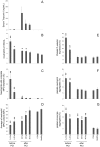An intense and short-lasting burst of neutrophil activation differentiates early acute myocardial infarction from systemic inflammatory syndromes
- PMID: 22761804
- PMCID: PMC3382567
- DOI: 10.1371/journal.pone.0039484
An intense and short-lasting burst of neutrophil activation differentiates early acute myocardial infarction from systemic inflammatory syndromes
Abstract
Background: Neutrophils are involved in thrombus formation. We investigated whether specific features of neutrophil activation characterize patients with acute coronary syndromes (ACS) compared to stable angina and to systemic inflammatory diseases.
Methods and findings: The myeloperoxidase (MPO) content of circulating neutrophils was determined by flow cytometry in 330 subjects: 69 consecutive patients with acute coronary syndromes (ACS), 69 with chronic stable angina (CSA), 50 with inflammation due to either non-infectious (acute bone fracture), infectious (sepsis) or autoimmune diseases (small and large vessel systemic vasculitis, rheumatoid arthritis). Four patients have also been studied before and after sterile acute injury of the myocardium (septal alcoholization). One hundred thirty-eight healthy donors were studied in parallel. Neutrophils with normal MPO content were 96% in controls, >92% in patients undergoing septal alcoholization, 91% in CSA patients, but only 35 and 30% in unstable angina and AMI (STEMI and NSTEMI) patients, compared to 80%, 75% and 2% of patients with giant cell arteritis, acute bone fracture and severe sepsis. In addition, in 32/33 STEMI and 9/21 NSTEMI patients respectively, 20% and 12% of neutrophils had complete MPO depletion during the first 4 hours after the onset of symptoms, a feature not observed in any other group of patients. MPO depletion was associated with platelet activation, indicated by P-selectin expression, activation and transactivation of leukocyte β2-integrins and formation of platelet neutrophil and -monocyte aggregates. The injection of activated platelets in mice produced transient, P-selectin dependent, complete MPO depletion in about 50% of neutrophils.
Conclusions: ACS are characterized by intense neutrophil activation, like other systemic inflammatory syndromes. In the very early phase of acute myocardial infarction only a subpopulation of neutrophils is massively activated, possibly via platelet-P selectin interactions. This paroxysmal activation could contribute to occlusive thrombosis.
Conflict of interest statement
Figures



References
-
- Michelson AD, Barnard MR, Krueger LA, Valeri CR, Furman MI. Circulating monocyte-platelet aggregates are a more sensitive marker of in vivo platelet activation than platelet surface P-selectin: studies in baboons, human coronary intervention, and human acute myocardial infarction. Circulation. 2001;104:1533–1537. - PubMed
-
- Ferrante G, Nakano M, Prati F, Niccoli G, Mallus MT, et al. High levels of systemic myeloperoxidase are associated with coronary plaque erosion in patients with acute coronary syndromes: a clinicopathological study. Circulation. 2010;122:2505–2513. - PubMed
-
- Goldmann BU, Rudolph V, Rudolph TK, Holle AK, Hillebrandt M, et al. Neutrophil activation precedes myocardial injury in patients with acute myocardial infarction. Free Radic Biol Med. 2009;47:79–83. - PubMed
-
- Weber C, Zernecke A, Libby P. The multifaceted contributions of leukocyte subsets to atherosclerosis: lessons from mouse models. Nat Rev Immunol. 2008;8:802–815. - PubMed
Publication types
MeSH terms
Substances
LinkOut - more resources
Full Text Sources
Medical
Research Materials
Miscellaneous

